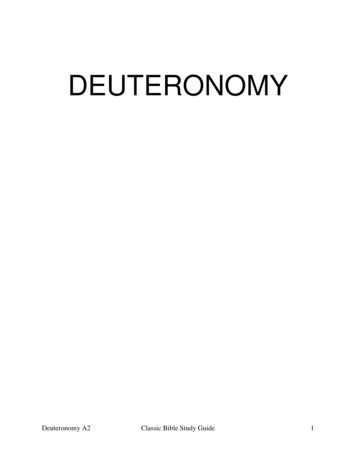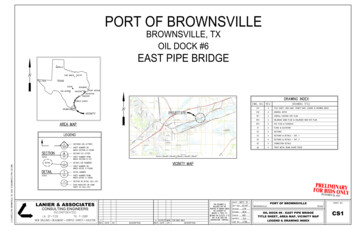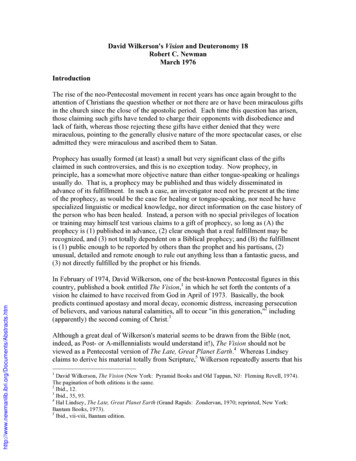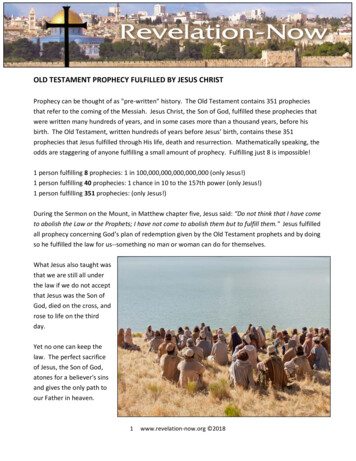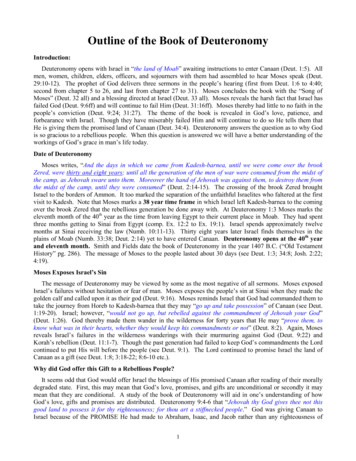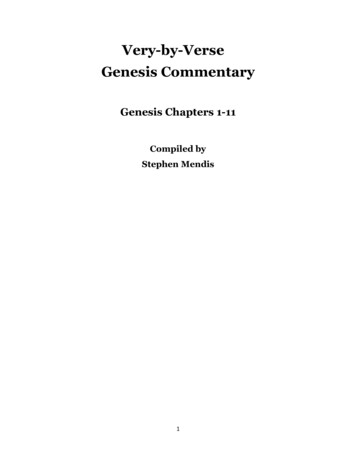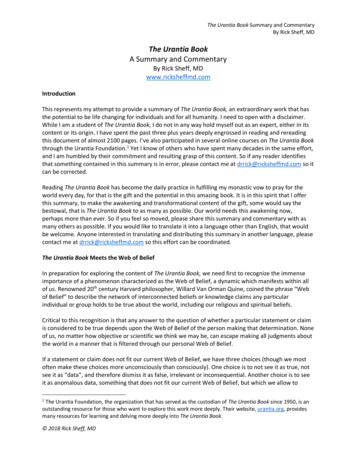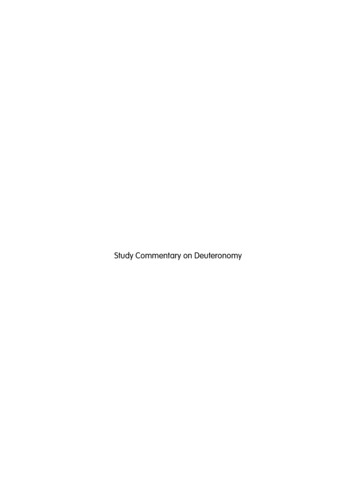
Transcription
Study Commentary on Deuteronomy
A Study CommentaryonDeuteronomyJohn D. Currid
EVANGELICAL PRESSFaverdale North, Darlington, DL3 0PH, Englande-mail: sales@evangelicalpress.orgEvangelical Press USAP. O. Box 825, Webster, New York 14580, USAe-mail: usa.sales@evangelicalpress.orgweb: http://www.evangelicalpress.org John Currid 2006All rights reserved. No part of this publication may bereproduced, stored in a retrieval system or transmitted, inany form, or by any means, electronic, mechanical, photocopying, recording or otherwise, without the prior permission of the publishers.First published 2006British Library Cataloguing in Publication Data availableISBN-13 978-0-85234-627-3ISBN 0-85234-627-1Unless otherwise indicated, Old Testament Scripturequotations are the author’s own translation.New Testament Scripture quotations, unless otherwiseindicated, and Old Testament quotations marked ‘NASB’are taken from the NEW AMERICAN STANDARD BIBLE ,Copyright 1960, 1962, 1963, 1968, 1971, 1972, 1973,1975, 1977, 1995 by The Lockman Foundation. Used bypermission.Printed and bound by Gutenberg Press, Malta.
ContentsGlossary of linguistic termsIntroductory mattersDeuteronomy as an ancient Near-Easternvassal treatyThe structure of Deuteronomic lawThe concept of law in the ancient Near East1. Preamble(Deuteronomy 1:1-8)2. Historical prologue(Deuteronomy 1:9 – 4:43)The appointment of officials (1:9-18)The spies and their report (1:19-33)Yahweh responds to rebellion (1:34-46)Israel and Edom in the wilderness (2:1-7)Israel and Moab in the wilderness (2:8-15)Israel, Ammon and Sihon (2:16-37)Israel, Bashan and Og (3:1-11)The allocation of Transjordan (3:12-22)Moses denied entrance (3:23-29)Israel must live by the Word of God (4:1-8)Yahweh at Horeb (4:9-24)Warning of exile 108
The uniqueness of Yahweh (4:32-40)Cities of refuge (4:41-43)3. Stipulations: The Decalogue(Deuteronomy 4:44 – 5:33)Introduction to the Torah (4:44-49)Moses summons Israel (5:1-6)The First Commandment (5:7)The Second Commandment (5:8-10)The Third Commandment (5:11)The Fourth Commandment (5:12-15)The Fifth Commandment (5:16)The Sixth Commandment (5:17)The Seventh Commandment (5:18)The Eighth Commandment (5:19)The Ninth Commandment (5:20)The Tenth Commandment (5:21)Moses the mediator (5:22-33)4. Exposition of the First Commandment(Deuteronomy 6:1 – 11:32)The Shema (6:1-9)Fear Yahweh only (6:10-19)Instructing the children (6:20-25)Warnings against idolatry (7:1-11)Keeping covenant (7:12-16)Do not fear (7:17-26)Blessings of the covenant (8:1-10)Curses of the covenant (8:11-20)A consuming fire (9:1-6)Examples of a stiff-necked people (9:7-24)A prayer of Moses (9:25-29)The second set of tablets (10:1-11)How is Israel to respond? (10:12-22)Rewards for obedience (11:1-17)The great commandment 235242
5. Exposition of the Second Commandment(Deuteronomy 12:1-31)6. Exposition of the Third Commandment(Deuteronomy 12:32 – 14:21)Apostasy in the community (12:32 – 13:18)The laws of kashrut (14:1-21)7. Exposition of the Fourth Commandment(Deuteronomy 14:22 – 16:17)The tithe (14:22-29)The sabbatical year (15:1-11)Sabbatical release of the debt-slave(15:12-18)The law of the firstborn male (15:19-23)The festival calendar of the Hebrews(16:1-17)8. Exposition of the Fifth Commandment(Deuteronomy 16:18 – 18:22)Appointment of judges (16:18 – 17:13)Appointment of kings (17:14-20)Authority of the Levitical priests (18:1-8)Call of the prophet (18:9-22)9. Exposition of the Sixth Commandment(Deuteronomy 19:1 – 22:12)Cities of refuge (19:1-13)Witnesses (19:14-21)Laws of warfare: who shall fight? (20:1-9)Besieging a city (20:10-18)Cutting down trees for warfare (20:19-20)Atonement for murder (21:1-9)Laws of the captive bride (21:10-14)A rebellious son (21:15-21)Execution by hanging (21:22-23)Sundry laws for daily life 6320326327332336341345347351354357359
10. Exposition of the Seventh Commandment(Deuteronomy 22:13 – 23:14)Illicit sexual conduct (22:13-29)The holiness of the people of God(22:30 – 23:14)11. Exposition of the Eighth Commandment(Deuteronomy 23:15 – 24:7)365366374Cases of stealing (23:15-25)Further cases of stealing (24:1-7)38138238812. Exposition of the Ninth Commandment(Deuteronomy 24:8-16)39413. Exposition of the Tenth Commandment(Deuteronomy 24:17 – 26:19)Rights of the underprivileged (24:17-22)Sundry laws concerning coveting (25:1-19)Offerings of the first fruits (26:1-15)Conclusion to the exposition of the law(26:16-19)14. Sanctions: Blessings and curses of the covenant(Deuteronomy 27:1 – 29:1)Ceremony on the mounts (27:1-26)Blessings (28:1-14)Curses, again! (28:15 – 29:1)15. Summons to the oath of the covenant(Deuteronomy 29:2 – 30:20)The oath of the covenant (29:2-21)Future generations of idolaters (29:22-29)Restoration to the covenant (30:1-10)The call for a decision 70
16. Witnesses to the covenant(Deuteronomy 31:1-29)The first witness: the law (31:1-13)The second witness: the song (31:14-23)The third witness: heavens and earth(31:24-29)47447548148617. The Song of Moses(Deuteronomy 31:30 – 32:47)49118. The Blessing of Moses(Deuteronomy 32:48 – 33:29)51619. The death of Moses and its testamentarysignificance (Deuteronomy 34:1-12)533Appendix I: The Decalogue in Exodus539539549Appendix II: The kashrut or dietary laws in Leviticus557List of abbreviationsNotes571573Vertical commandsHorizontal commands
Glossary of linguistic termsanaphora: the repetition of a word or phrase at thebeginning of successive clausesapodictic: clearly established or beyond disputeapodosis: the main clause of a conditional sentence(see also protasis)aposiopesis: the rhetorical device of suddenly breaking off in speechasyndeton: the omission or absence of a conjunctionbetween parts of a sentencecasus pendens — see extrapositionchiasmus (derivative chiastic): literary figure inwhich words, grammatical constructions, or concepts are repeated in reverse order, in the same ora modified formepistrophe: the repetition of a word at the end ofsuccessive clauses or sentencesextraposition: the placing of a word or group ofwords outside, or at the end of, a clause, while retaining the sense
hapax legomenon: a term of which only one instance of use is recordedhendiadys: the expression of a single idea by twowords connected with ‘and’inclusio: a repeated theme which both introducesand concludes a passage, and thus encompassesthe wholemerism: a pair of opposites that are all-inclusivemetonymy: the substitution of the name of anattribute or adjunct for that of the thing meantparenesis: an exhortatory compositionprotasis: the clause expressing the condition in aconditional sentence (see also ‘apodosis’)synecdoche: a figure of speech in which a part ismade to represent the whole, or vice versa
Introductory mattersDeuteronomy as an ancient Near-Easternvassal treatyIt has long been recognized that the book of Deuteronomy is set up according to the structure of anancient Near-Eastern suzerain/vassal treaty orcovenant.1 In the ancient Near East, there existed twotypes or forms of covenant: those governing relationships between equal parties and those specifyingrelationships between unequal parties. The secondtype of covenant was between an overlord (the superior, also called a suzerain) and a vassal (theinferior party). Many of these covenants were between a king and his subjects. Within this form, thesuzerain, as the more powerful party, took on most ofthe responsibility for the stipulations of the covenant.Although the vassal also had some obligations,because of limited capabilities and resources, he wasnot held accountable to the same extent and degreeas the suzerain.Well over half the suzerain/vassal treaties uncovered through archaeology come from the HittiteEmpire of the second millennium B.C. Some covenant documents are extant from the first millenniumB.C. from the Hittites, Assyrians, Egyptians andothers. But the book of Deuteronomy most closelyresembles the second-millennium treaty documents
14Study Commentary on Deuteronomyof the Hittites. I will suggest later that this fact iscritical for a proper dating of Deuteronomy.1. An example of a second-millennium Hittite treaty:Mursilis of Hatti and Duppi-Tessub of AmurruMursilis II was a powerful monarch of the Hittitesduring the last half of the fourteenth century B.C.When he ascended to the throne many states thathad been vassals to Hatti were in rebellion. In particular, the powerful kingdom of Arzawa had assertedits independence. Mursilis II responded with militaryforce. ‘By a great campaign which lasted two years,and of which we have a very detailed account, Arzawa was completely crushed, its king was slain, andHittite nominees were installed as rulers of the several kingdoms.’2 During his reign, Mursilis II suppressed the revolts in almost all of the affected kingdoms. By the time he died and left the kingship to hissuccessor, he had a firmly established empire surrounded by numerous vassal kingdoms.One of the vassal kingdoms under full control ofthe Hittites was Amurru. This relationship is confirmed by the fact that Mursilis II installed a mannamed Duppi-Tessub as King of Amurru, and hebound that king and his population to him by anoath/treaty.3 A copy of that treaty document hasbeen found, copied and translated.4 A comparisonwith other covenant agreements dating from thesecond millennium reveals that this oath has manyfeatures and elements in common with them. A briefreview of these elements will be helpful at this point:1. The treaty between Mursilis and DuppiTessub begins with a preamble, and this consistsof words that are spoken by the suzerain. It begins: ‘These are the words of the Sun Mursilis,
Introductory mattersthe great king, the king of the Hatti land, the valiant ’5 The purpose of a preamble in a covenantdocument is the identification, or selfidentification, of the suzerain, or great king, andit is given in terms that are intended to inspireawe and fear in the vassal.2. The preamble is followed by a historicalprologue. This section is a survey of the previous relations of, or history between, the twoparties. Mursilis reminds Duppi-Tessub of hisvassal status, and that was the same positionthat his father and grandfather had in relationto the Hittite state. The Hittite king reminds himthat his ancestors were loyal, true and enjoyedbeing under the leadership of the Hittite court.3. The next feature of the covenant is thelargest, and that consists of the stipulations ofthe treaty. These spell out the obligations thateach party has under the terms of the oath. Onthe vassal side, Duppi-Tessub is required to bethoroughly committed to the treaty. Mursilissays in the text, ‘So honour the oath [of loyalty]to the king and the king’s kin!’ In response,Mursilis offers reciprocity: ‘And I, the king, willbe loyal toward you.’ Amurru is to pay tribute tothe Hittites, and it consists of ‘300 shekels ofgood, refined first-class gold weighed with standard weights’. In return, Mursilis says that hewill give Amurru military protection.4. The next step is a witness clause. HereMursilis calls on the gods to bear witness to thetreaty between himself and Duppi-Tessub. Healso invokes various parts of nature to testify tothe oath: ‘ the mountains, the rivers, thesprings, the great Sea, heaven and earth, thewinds [and] the clouds let these be witnessesto this treaty and to the oath.’15
16Study Commentary on Deuteronomy5. Sanctions are then listed. These are theblessings and curses invoked on the vassal depending on whether or not he keeps the covenant. If he is disloyal, Mursilis calls on the godsto destroy everything that is owned by DuppiTessub, including his family, house and land.However, if he proves to be true to the oath,then the gods are called upon to protect all thatbelongs to him. No sanctions are mentioned inrelation to the suzerain because it is assumedthat he will keep his word.6. This treaty includes a statement of display.This is mentioned in the last paragraph of thedocument, which states that this oath is inscribed on a tablet. Thus, there exists a tangibleconfirmation of the covenant that has beenmade.7. Other treaties from the second millenniumB.C. in our possession from Hatti include otherelements not seen in the document concerningMursilis and Duppi-Tessub. Such things as anoath of obedience on the part of the vassal, a solemn ceremony or covenant ratification ritual anda stated formal procedure against rebellious vassals are common features of these treaties.6The book of Deuteronomy is structured accordingto a suzerain/vassal treaty of the second millenniumB.C. The points of correspondence are obvious:1. Deuteronomy 1:1-8 is a preamble. It begins with the same words as the Mursilis treaty:‘These are the words ’ The section identifiesMoses as the speaker of the words of the covenant document, and he is serving as the one whospeaks for the suzerain, Yahweh.2. Deuteronomy 1:9 – 4:43 is a review of thehistory of the relationship between Yahweh and
Introductory matters17Israel from the time of the covenant promises toAbraham until their present position in theplains of Moab.3. This is followed by the stipulations of thecovenant that run from Deuteronomy 4:44 –26:19. These constitute the longest section ofthe covenant document, which is a reiteration ofthe Decalogue from Mount Sinai and a detailedexposition of those laws. It deals primarily withthe expectations that the suzerain has regarding the behaviour of the vassal.4. The sanctions, or blessings and curses ofthe covenant, then appear. It is clear that if Israel obeys the stipulations of the covenant, thenshe will be blessed; if not, then she will becursed. These sanctions are found in Deuteronomy 27:1 – 29:1.5. A statement of display is found in Deuteronomy 27:1-4. When the Israelites cross theJordan River into the promised land, then theyare to erect a series of large stones, coat themwith lime plaster and write on them the wordsof the covenant document that has been givento them. These are to serve as a symbol and areminder of the covenant promises and duties.6. Deuteronomy includes an oath of allegiance on the part of the vassal to the covenant(29:2 – 30:20), although this is not part of theMursilis treaty.7. The witnesses to the covenant are definedin Deuteronomy 31:1 – 32:47. There are three ofthem: the law itself is a witness; Moses andJoshua compose a song that serves as a witnessand, finally, Moses calls for heaven and earth tobe witnesses to the treaty.Obviously, the form and structure of the book ofDeuteronomy are the same as for the second-
18Study Commentary on Deuteronomymillennium treaty documents of the ancient NearEast. They do not look like the covenants of the firstmillennium B.C. Such parallels may have great forcein regard to the question of the dating of the book ofDeuteronomy.The parallel also demonstrates that the book ofDeuteronomy is an official document ratifying theformal covenant relationship between Yahweh asKing and Israel as vassal. It is recognition of Yahwehas the sovereign King, and it shows him to be in aspecial relationship with his covenant people.And, finally, the structure of Deuteronomy as atreaty document reflects a completeness and onenessas a single document. Its form underscores its homogeneity. It is uniformly a covenant document of thesecond millennium B.C., and it contains no, or veryfew, discordant elements. In my opinion, its overallform would argue against traditional source criticismwhich says that many divergent sources, authorsand editors came together to create this documentover hundreds and hundreds of years.The form of Deuteronomy as a covenant treaty hasdetermined the chapter divisions of this commentary.In other words, I comment on the text according tothe features of a treaty document: for instance,chapter 1 of the commentary is an exposition ofDeuteronomy 1:1-8, which is the preamble of thework. Chapter 2 of the commentary expounds Deuteronomy 1:9 – 4:43, which is the historical prologueof the text. And so we move through the text to theend.
The structure of Deuteronomic lawFor many decades, scholarship has been almostunanimous in its appraisal of the laws of Deuteronomy. Many commentators see these laws as simplyhaving been thrown together over the course of time;Deuteronomy is a random collection of laws withlittle rhyme or reason. A. C. Welch comments thatnothing ‘can be quite so bad as the order in which[the laws] appear in Deuteronomy today’.7 The reasonthat the book is poorly structured is because it is theconsequence of many hundreds of years of writing,editing and literary evolution. E. W. Nicholson puts itthis way: ‘It has been generally agreed that the bookof Deuteronomy in its present form is the final outcome of a long literary growth beginning with the socalled Urdeuteronomium and developing throughsuccessive stages of literary expansion until it assumed its present dimensions. This view is basedupon the presence in Deuteronomy of separate andapparently quite independent introductions andconclusions as well as other doublets and repetitions.’8 Von Rad echoes these sentiments when hesays, ‘The account is extraordinarily discontinuous.At frequent intervals the reader comes across interruptions and gaps in the sense. When we considerthe form too, we find the style of the speaker changing continually. We must conclude from all this thatDeuteronomy and the individual sections of which itis composed must have had an unusually complicated previous history.’9
20Study Commentary on DeuteronomyA few recent studies, however, have gone againstthe mainstream. Some have attempted to demonstrate that the book of Deuteronomy is not a literarymishmash of various laws haphazardly throwntogether. On the contrary, Deuteronomy is a highlystructured, well-formulated and symmetrical piece ofwork. In this regard, two works deserve to be mentioned: S. A. Kaufman’s ‘The Structure of the Deuteronomic Law’10 and J. H. Walton’s ‘Deuteronomy: AnExposition of the Spirit of the Law’.11The basic view is this: the laws of Deuteronomyare an expansion of the Ten Commandments withthe intent of demonstrating the application of theDecalogue to the nation of Israel. In other words, thelaws of Deuteronomy chapters 6-26 are descriptivelaws for the nation of Israel based upon the prescriptive laws of the commandments given at Sinai (Deuteronomy 5). The various laws expounded in chapters6-26 show the intent of the law by choosing exemplary cases, and these cases highlight the truth andapplication of the Decalogue. Thus the Ten Commandments stand as the foundational moral principles of Old Testament law, and the other laws arecase laws that demonstrate the application of themoral law to Israelite society.Kaufman believes, and I think he is correct, thatthe law of Deuteronomy is a highly structured composition arranged according to the order of the Decalogue found in Deuteronomy 5. This arrangementthus serves as a literary device that gives structure tothe legal material of Deuteronomy. But that is not allthat is here. Whereas Kaufman argues that thearrangement serves a merely literary function, this isnot enough.12 Walton comments, ‘An examination ofthe correlations of the various sections of Deuteronomy with the decalogue suggests, however, that thearrangement served more than a literary function.Rather, by his choice and classification of the legal
Introductory matters21material, Moses exemplified the “spirit” behind eachof the ten basic laws, the decalogue.’13According to this thesis, the laws of Deuteronomyare structured in the following manner:1. Deuteronomy 4:44 – 5:33These verses give the setting and the proclamation ofthe Ten Commandments, that which was written onthe stone tablets by Yahweh and given directly toMoses (5:22).2. Deuteronomy 6:1 – 11:32Scholars have observed for many centuries that thesechapters constitute an expansion of, and a commentary on, the First Commandment of the Decalogue.These chapters convey the idea of God as mankind’ssole authority, and that only he is worthy of mankind’s worship and obedience. This section openswith the great statement of the Shema: ‘Hear, OIsrael! Yahweh is our God, Yahweh is one!’ (6:4).3. Deuteronomy 12:1-31These verses are a commentary on the Second Commandment of the Decalogue. They call for the eradication of pagan cults and objects of veneration andworship: ‘You shall certainly destroy all the placeswhere the nations, whom you are dispossessing,serve their gods, on the high mountains and on thehills and beneath every fertile tree’ (12:2).4. Deuteronomy 12:32 – 14:21The prohibition against taking God’s name in vain isthe Third Commandment of the Decalogue. Theseverses comment on that moral law. The height of
22Study Commentary on Deuteronomyspeaking God’s name vainly is disclosed in the firstfive verses of the section, in which false prophets arecondemned for employing vain words that God hasnot revealed to them.5. Deuteronomy 14:22 – 16:17The Fourth Commandment is the law of the Sabbath.This section in the Deuteronomic law treats theentire festal calendar of Israel, and it is one that isbased on the sabbatic principle.6. Deuteronomy 16:18 – 18:22The Fifth Commandment of the Decalogue deals withthe specific issue of parental authority. However, it isnot limited to parental authority, but it deals with allhierarchical authority structures that God has created. In this section of Deuteronomy, the authoritative positions of judges, kings, priests and prophetsare treated in detail.7. Deuteronomy 19:1 – 22:12This is a commentary on the Sixth Commandment,which prohibits the killing of one human being byanother. It treats the issues of warfare, unintentionalhomicide, untraceable homicide and the punishments for such crimes.8. Deuteronomy 22:13 – 23:14The Seventh Commandment prohibits the act ofadultery. But, of course, it is meant to judge all formsof sexual impurity. This section of the law givesregulations concerning adultery and other illicitforms of sexual relations, such as incest.
Introductory matters239. Deuteronomy 23:15 – 24:7This passage deals with issues of theft and otherproperty violations. All of these are associated withthe concept of stealing, and they are included as partof the prohibition against stealing in the EighthCommandment.10. Deuteronomy 24:8-16This passage considers such matters as pledges andvows made to a neighbour. It deals with the idea ofkeeping one’s word. It teaches that it is important tobe upright and trustworthy when entering into agreements. As such, it is a commentary on the NinthCommandment.11. Deuteronomy 24:17 – 26:19The Tenth Commandment is a law setting out thefundamental principle that admonishes covetousness. Deuteronomy here expands that idea by restricting any violation against the rights and privileges of others. The rights of others in all matters areto be preserved.I must confess that not every passage in the law ofDeuteronomy fits comfortably and perfectly into thisstructure. At times, one feels as if one is putting asquare peg into a round hole. For example, how thelaws of Deuteronomy 21:10-14 fit into the prohibitionagainst murder is hard to see. These are laws treating the issue of women who are captured by Israelduring times of war. I will make a suggestion regarding the appropriateness of this text in its contextwhen I comment on the passage. But, in reality,there are only a few exceptions like this one. Andthese do not take away from the fact that the law of
24Study Commentary on DeuteronomyDeuteronomy is a highly structured and stylizedpiece of literature.It is also important to note that the arrangementof the law based on the Decalogue (Deut. 5) and itsapplication (Deut. 6-26) is quite similar to ancientNear-Eastern documents of jurisprudence. AncientNear-Eastern law documents contain four basiccategories: general prohibitions against murder,adultery, theft and false witness. These general lawsare then given teeth by the enumeration of variousexemplary laws that demonstrate the application tosociety of the general prohibitions. In this regard,Deuteronomy fits well with ancient Near-Easternlegal practices; it does not fit well with later (e.g.,post-exilic) periods in which such documents werenot written.In conclusion, Walton says, ‘Based on this preliminary study, it is suggested that a working hypothesis may be established that views the deuteronomic law (chaps. 6-26) as an expansion of thedecalogue with the intent of addressing the spirit ofthe law. That is, the decalogue has implicationsconcerning conduct that far transcend the limitednumber of issues that it addresses directly. Theauthor is accomplishing this task by choosing exemplary cases that are intended to highlight the attitudes implied by the initial commandment.’14 I whollyconcur with these sentiments.
The concept of law in the ancient Near EastIt may be obvious, but must not be left unsaid, thatthe Mosaic legislation is not the earliest law code inthe ancient Near East. In Mesopotamia, for instance,there are law codes that antedate the Pentateuch bycenturies. There are, indeed, some attributes that setapart the Mosaic legislation, but its early dating isnot one of them. The best-known law document isthe Code of Hammurabi, who was king during theOld Babylonian dynasty (c. 1728-1686 B.C.). Thatcode pre-dates the Mosaic regulations by at least 300years. Yet there are legal codes in Mesopotamia thatare even earlier than the Code of Hammurabi: forexample, the Lipit-Ishtar Law Code (from the firsthalf of the nineteenth century B.C.) and the Laws ofEshnunna (at the turn of the nineteenth centuryB.C.). To view these two texts in translation, thereader should consult the commonly availablebooks.15Some authors argue that the Mosaic legislationowes much of its form and content to the earlierMesopotamian law codes. In this introductory section, we shall test briefly this latter assumption orhypothesis. In this regard we need to consider theCode of Hammurabi because it is the most developedof the early law codes, and then we shall compare itscomposition, structure and content to the Mosaiclegislation. Such a study can provide some importantinsights into the biblical text of Deuteronomy.
26Study Commentary on DeuteronomyHistory of the Code of HammurabiThis legal code was a series of royal decisions, dulyrecorded and collected together to be used as areference by judges of future generations. It probablyreflects the common law of Mesopotamia for centuries. Yet it was most likely merely an ideal law —that is, there is no evidence from contemporary legaldocuments that these laws were carried out to theirfull extent or degree. Thomas puts it this way: ‘Oneextraordinary fact is that, great as was his prestigeas a ruler and his achievement in formulating thelaws, the Code seems to have remained merely anideal lacking practical application. There is no evidence in the contemporary legal documents that theprovisions of the Hammurabi Code were ever carriedout, and to all intents and purposes it might not haveexisted for them.’16Hammurabi ordered that copies of the code shouldbe carved on steles and placed at various locationsthroughout the land, in particular, in temple complexes. One of these was discovered at Susa at thebeginning of the twentieth century; it evidently wasused as a boundary stone or marker. Various fragments of the code have been found elsewhere inMesopotamia. And these pieces are not only widespread, but they are spread over a long period oftime: they date anywhere from the eighteenth century to the sixth century B.C. That, of course, reflectsa widely distributed and long-lasting impact on thelegislation of the history of Babylonia.The stele from Susa is approximately eight feet (orjust under two and a half metres) high. At the top ofthe stone is a carved scene of Hammurabi receiving aring and a sceptre from Shamash, who is both thesun-god and the god of justice. Some believe thatShamash is giving the laws to Hammurabi, but thatis probably not the case. It appears from the carving
Introductory matters27that Shamash is merely commissioning Hammurabito compose a law book. The text itself confirms theauthorship of the code as belonging to Hammurabi:he calls the code ‘the laws of justice, which Hammurabi, the efficient king, set up, and by which hecaused the land to take the right way and have goodgovernment’ (opening lines of epilogue).The remainder of the stele is inscribed with thelaw code in three parts. It is written from top tobottom.1. PrologueThis opening section explains the various purposes ofthe law. They are relatively humanistic and humanitarian, and they form a legal document that is primarily concerned with the operation of human society. The text says:Me, Hammurabi, the devout, god-fearing prince,to cause justice to prevail in the land,to destroy the wicked and the evil,that the strong might not oppress the weak The remainder of the prologue focuses on the greatness and the great deeds of Hammurabi.2. LawsThe bulk of the document provides 282 laws thattreat a myriad of issues affecting society. Theseinclude general areas of crime, trade, marriage,family, property rights, wages, slavery and variousother legal matters.
28Study Commentary on Deuteronomy3. EpilogueAgain, the greatness of Hammurabi is spelled out ingreat detail. In addition, we read of sanctions — thatis, divine punishments for anyone who defaces themonument containing the Code, or who alters ‘thelaws of justice, which Hammurabi, the efficient king,set up ’A brief comparison with the Mosaic legislationThis comparison between the Code of Hammurabiand the Pentateuch has
Yahweh responds to rebellion (1:34-46) 52 Israel and Edom in the wilderness (2:1-7) 58 Israel and Moab in the wilderness (2:8-15) 62 . It has long been recognized that the book of Deuter-onomy is set up according to the structure of an ancient Near-Eastern suzerain/


